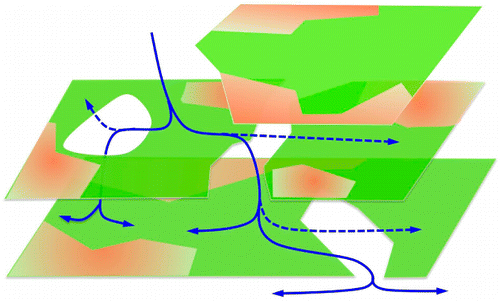August 14, 2013 weblog
Researchers observe new type of ice forms between layers of graphene oxide

(Phys.org) —A combined team of researchers from Korea and The Netherlands has discovered a new type of ice that forms between layers of graphene oxide. In their paper published in the journal Nano Letters, the team describes the ice's properties and how they caused the ice to form.
The new type of ice was discovered via atomistic modeling which allowed the researchers to control its development. The new type of ice, a form of bilayer ice, can only form under very special conditions. In this new effort, the researchers were experimenting with graphene oxide films, which are unique because they allow water, but no other liquids or gasses, to pass through.
In their model, graphene oxide layers were stacked one on top of one other and then water was allowed to pass through one of the membranes where it was chilled to below freezing at the junction point. The water between froze into a lattice pattern very similar to the membrane. To create the bilayer ice, more water was allowed to pass through the membrane, freezing on top of the first layer. Rather than adhering to one another as would occur with normal ice, the two layers of ice actually slide against one another, in a zig-zag fashion as they follow the lattice pattern. This is because, the researchers explain, the water makes its way through the membrane in a special way—one that allows for the water to freeze into a new kind of ice crystal shape.
The researchers note that normally when (reduced) graphene oxide is layered, the distance between the two pieces is just 0.6 nm—enough for just one layer of water to freeze into ice. To allow for two layers, the researchers used unreduced graphene oxide which allowed for a span of 0.9 nm—enough extra space to allow for a second layer of ice to form.
The newly found properties of graphene oxide and ice formation could lead to new types of filters or membranes that are capable of separating different substances. Also, if the graphene oxide were doped with nitrogen, the researchers note, the possibility exists for creating a new type of catalyst.
More information: Origin of Anomalous Water Permeation through Graphene Oxide Membrane, Nano Lett., 2013, 13 (8), pp 3930–3935. DOI: 10.1021/nl4020292
Abstract
Water inside the low-dimensional carbon structures has been considered seriously owing to fundamental interest in its flow and structures as well as its practical impact. Recently, the anomalous perfect penetration of water through graphene oxide membrane was demonstrated although the membrane was impenetrable for other liquids and even gases. The unusual auxetic behavior of graphene oxide in the presence of water was also reported. Here, on the basis of first-principles calculations, we establish atomistic models for hybrid systems composed of water and graphene oxides revealing the anomalous water behavior inside the stacked graphene oxides. We show that formation of hexagonal ice bilayer in between the flakes as well as melting transition of ice at the edges of flakes are crucial to realize the perfect water permeation across the whole stacked structures. The distance between adjacent layers that can be controlled either by oxygen reduction process or pressure is shown to determine the water flow thus highlighting a unique water dynamics in randomly connected two-dimensional spaces.
via Nanotechweb
Journal information: Nano Letters
© 2013 Phys.org




















